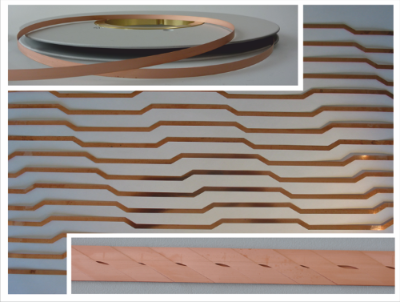AC Conductors and Cables

The focus is on the development of superconducting tapes and cables for alternating current applications with all technically required properties. These applications include rotating machines, transformers or accelerator magnets, which place high demands on the current carrying capacity, efficiency and electrical and mechanical stability of the conductors. Due to their geometric properties, increasing the current carrying capacity and reducing the alternating current losses (AC losses) is a major challenge, especially for 2nd generation high-temperature superconductors, the REBCO (RE-Ba-Cu-O, RE = Rare Earth Element) tape conductors. Common methods of loss reduction and current increase, such as filamentation and stranding, are difficult to implement due to the tape geometry.
Laser structuring
Superconductor tapes are taylored with filament structures to reduce alternating current losses. These are produced at the ITEP using a modern picosecond Nd:YAG pulse laser.

Technical Features:
A Nd:YAG laser with a wavelength of 1030 nm is used. This is pulsed with a frequency of 400 kHz. The pulse duration is less than 10 ps. The optimum combination of pulse power, pulse length and laser wavelength minimizes the heat input into the material. The maximum power of the laser is 25 W with a maximum pulse energy of 125 µJ. This also allows laser cutting. The beam width is approximately 20 µm and the repeatability of a laser track is 0.5 µm. A combination of scanner optics with a speed of 90 m/min and a moving table with 22.5 m/min in a reel-to-reel arrangement is used for structuring.
Since the system is freely programmable with regard to structures, complex structure images are possible. Besides the production of low AC-loss conductors, the laser system is also used for other applications. These are, for example, micro-undulators or special patterns for better characterization of samples.
Roebel Cables
 The concept of the Roebel cable or Roebel bar was invented and patented by Ludwig Roebel more than 100 years ago [1]. It represents a concept for improving the efficiency and increasing the output in large machines. At the Institute of Technical Physics, this concept was first applied by W. Goldacker [2] in 2005 to produce a fully transposed cable from REBCO coated conductors, thus reducing coupling losses. Since then, REBCO roebel cables have been thoroughly researched at ITEP through modeling and experimentation, and manufacturing methods have been further optimized to meet the requirements of various applications. A particular focus has been placed on the precision of the punching process required to bring commercial REBCO tapes into the meandering geometry required for cabling. The production of Roebel cables with a length of about 100 m was successfully demonstrated. Roebel cables produced at the ITEP were successfully used by partners in magnetic windings, e.g. for the Feather-M2 winding at CERN [3].
The concept of the Roebel cable or Roebel bar was invented and patented by Ludwig Roebel more than 100 years ago [1]. It represents a concept for improving the efficiency and increasing the output in large machines. At the Institute of Technical Physics, this concept was first applied by W. Goldacker [2] in 2005 to produce a fully transposed cable from REBCO coated conductors, thus reducing coupling losses. Since then, REBCO roebel cables have been thoroughly researched at ITEP through modeling and experimentation, and manufacturing methods have been further optimized to meet the requirements of various applications. A particular focus has been placed on the precision of the punching process required to bring commercial REBCO tapes into the meandering geometry required for cabling. The production of Roebel cables with a length of about 100 m was successfully demonstrated. Roebel cables produced at the ITEP were successfully used by partners in magnetic windings, e.g. for the Feather-M2 winding at CERN [3].

References:
[1] Patent DE277012: "Leiter für elektrische Maschinen, welcher aus zwei oder mehr Gruppen von Teilleitern besteht." Registered March 19, 1912, published July 25, 1914. Applicants: AG Brown, Boveri & Cie., Inventor: Ludwig Roebel.
[2] W. Goldacker et.al., Journal of Physics: Conference Series 43 (2006) 901-904.
[3] G.A. Kirby et.al., IEEE Transactions on Applied Superconductivity 27 (2017) 4003307.
